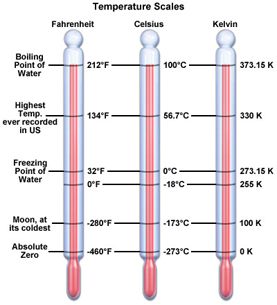Difference between revisions of "Thermometry pchem lec"
Jump to navigation
Jump to search
| Line 9: | Line 9: | ||
[[File:temperature_scale.jpg|400px]] | [[File:temperature_scale.jpg|400px]] | ||
| − | === | + | ===Temperature is never measured!=== |
:We measure other system variable and then relate this back to temperature/average kinetic energy of the particles. | :We measure other system variable and then relate this back to temperature/average kinetic energy of the particles. | ||
::- Most common is change in volume as a function of changes in temperature | ::- Most common is change in volume as a function of changes in temperature | ||
Latest revision as of 13:09, 28 August 2020
Thermometry: measuring temperature.
Q1: What is temperature? Just a number?
- A1 - the degree or intensity of heat present in a substance.
- A2 - a measurement of the average kinetic energy of a particle in a system; 3/2kT <--per molecule
Q2: How do we measure temperature?
- A1 - Most commonly we use a thermometer.
Temperature is never measured!
- We measure other system variable and then relate this back to temperature/average kinetic energy of the particles.
- - Most common is change in volume as a function of changes in temperature
- - changes is voltage as a function of changed in temperature (thermocouple, used for measuring very hot environments, like kilns or flames.
- - changes is color as a function of changed in temperature (thermochromic)
- - changes is pressure as a function of changed in temperature (used to develop the idea of an absolute zero, zero pressure zero temperature.)
- - IR light emission (intensity/wavelength) as a function of temperature, IR thermometer.
